SUMMARY
This is AI generated summarization, which may have errors. For context, always refer to the full article.
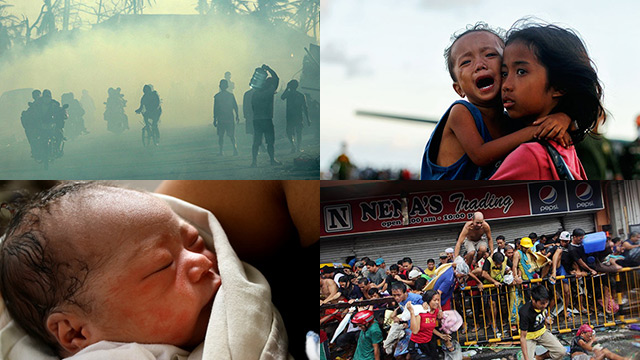
MANILA, Philippines – When Yolanda (Haiyan) slammed into the coastlines of Leyte and Eastern Samar on Friday, November 8, the government committee tasked to deal with its aftermath found itself without the two most important tools it had relied on in previous disasters: communication and local government.
A day before, the President’s most trusted Cabinet Secretaries, Interior and Local Government Secretary Mar Roxas and Defense Secretary Voltaire Gazmin flew to Tacloban City. They came without satellite phones or military radios. They went with the thought they would merely support the local government which, in Roxas’ words, was the “first responder” based on “our doctrine, or on our framework.”
Yolanda completely cut off all communication lines in Leyte and Eastern Samar. It also ruined the airport in Tacloban City, the alternative but slower means of communication. Worse, all roads leading to and from the two provinces were destroyed.
And worst still, it paralyzed local governments, sweeping away the homes of local executives, cops and soldiers, killing a number of them, and harming their families.
The world’s strongest typhoon wiped out government’s existing template for disaster management and response. But was it fast enough to pick up the pieces and respond?
Not fast enough, the anguished victims would tell reporters or anyone who cared to ask. With dead bodies still littering Tacloban’s streets, most villages remaining incommunicado, and thousands of them still having no food to eat or clean water to drink, even a day seemed like an eternity. And each day that passed without government presence was understandably hellish.
One week after
On Friday, November 15, a week after Super Typhoon Yolanda ravaged central Philippines, the Palace admitted it was still working to get aid to all affected areas. At least 10 of Leyte’s 40 towns were still not reached because the government did not have enough trucks to deliver the goods.
In Tacloban City, Leyte, the hardest hit locality, 82 out of 138 barangays have been provided with relief goods leaving 56 still scrambling for basic needs.
In Eastern Samar, only a third of affected areas have received aid – 8 of 24.
In the meantime, thousands of survivors have fled Samar and Leyte, some to Manila, others to Cebu, and still others to surrounding provinces that were not as affected by the storm. Leyte and Eastern Samar suffered the most damage after unprecedented storm surges of up to 5-6 meters hit those provinces and washed away houses.
The national government has reprogrammed the 2013 budget and said up to P26.84 billion is available for the relief, rescue and rehabilitation of Typhoon Haiyan victims. The super typhoon left 3,633 dead as of Saturday, November 16.
Rappler looks at how the national government has responded to the aftermath, and how it addressed 6 different issues in the wake of the storm.
COMMAND AND ORGANIZATION
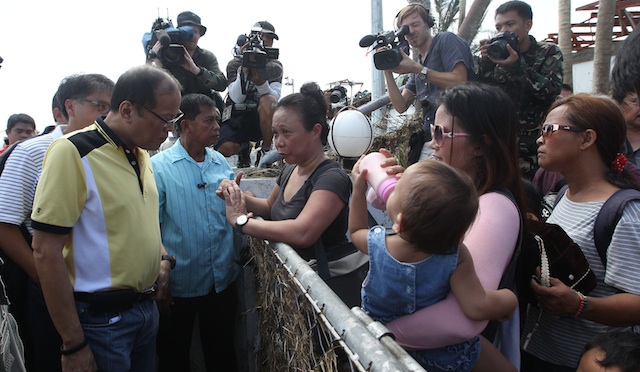
Situation:
By mid-morning of Friday, November 8, local government units (LGUs) were unreachable with all of Tacloban City completely disconnected from the outside world. City Mayor Alfred Romualdez was last seen clinging onto a post outside his beach resort, as he and his family too were victims of the storm. With LGUs and their personnel rendered completely helpless, there was no leadership on the ground and the national government had no point persons.
While Gazmin and Roxas had been in Tacloban as early as Thursday, they too were unreachable after the storm hit. At that point, power and communications were also completely down. Neither Roxas nor Gazmin had a satellite phone with them, suggesting the national government was not prepared for the worst possible scenario. They were able to make contact Friday evening.
Response:
On Friday, the Palace spent all day after the storm trying to establish contacts with LGUs. The national government was at a loss, since it relies heavily on local officials for information when it comes to disasters. In an interview with CNN, Roxas said “In our doctrine, or in our framework, the local government unit is the first responder, the national government [is] supposed to come at day 2 or day 3 to be able to support that.”
This suggests the national government stuck to this doctrine during prepations for Yolanda and did not consider the possibility of LGU breakdown as well.
By Saturday, November 9, the national government finally made progress in reconnecting with some LGUs, and mayors were directed to assess and report the extent of damage in their areas.
Two C130s flew to Tacloban carrying Executive Director Eduardo Del Rosario of the National Disaster Risk Reduction Management Council (NDRRMC), Social Welfare Secretary Dinky Soliman, and Commanding General of the Philippine Air Force Lieutenant General Lauro Dela Cruz, among others, to survey the damage. Over the next few days, more Cabinet Secretaries were assigned to various tasks, to assist the NDRRMC, which is the responsible agency when it comes to dealing with disasters.
President Benigno Aquino III visited Tacloban City by the 3rd day and on Monday, declared a state of national calamity. Despite the declaration, however, and the Cabinet Secretaries on the ground, international news agencies questioned why there was not an organized, large-scale relief distribution effort even on the 5th day since the storm.
By the 6th day, the Palace announced Aquino himself would be directly in charge of relief operations. He is expected to fly to Leyte to oversee aid distribution and cadaver recovery on Sunday, November 16.
RELIEF DISTRIBUTION
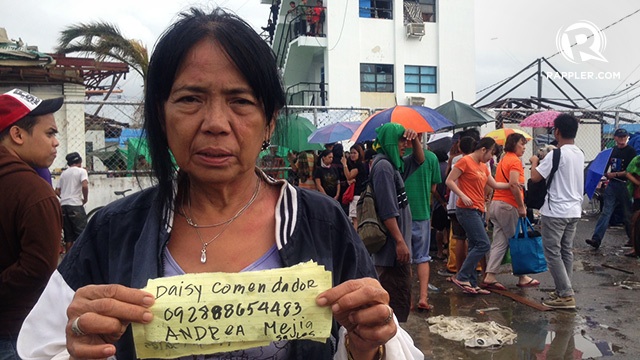
Situation:
Stories of starving survivors’ desperation, scrambling and looting for food, immediately made headlines as early as Day 1. Prepositioned supply set aside by the government were also swept away by the typhoon. In the next few days, aid trickled in slowly but delivery remained a problem. Aquino on Day 2 said “moving the food from areas where there is an abundance is a main problem. We have to clear the roads also, for land transport from the neighboring island and provinces of Samar.”
The national government also pointed to the breakdown in local governments as a major challenge, because it stalled “the coordination of relief goods distribution,” according to Secretary to the Cabinet Rene Almendras.
On Day 5, he acknowledged the slow movement of aid and admitted the national government needed help to get to them. By Day 6, relief distribution picked up with the opening of supply routes. A week since the storm, some affected areas have yet to be reached.
Response:
The day after the storm, two C-130s carrying relief goods landed in Tacloban City. Aid started to pile up in the next few days but without transportation for relief workers and debris littered throughout the city, supply delivery remained a challenge. (The military only has 3 operational C130s.)
In the next few days, the Department of Social Welfare and Development (DSWD) continued limited distribution of goods to Guiuan, Eastern Samar; Tacloban City; and Leyte but not all victims in these areas received food packs, let alone those in remote areas. The farthest islands in Guiuan went 4 days without food.
It was only on Day 5 when 2 other distribution hubs were set up in addition to Tacloban City: Ormoc City in Leyte, and Guiuan in Eastern Samar. The hubs finally helped hasten relief operations.
Tangible progress in aid distribution was felt on Day 6, when the Armed Forces of the Philippines deployed 8 trucks to deliver food and water to affected areas. On that day, the government claimed it reached 30 of 40 towns in Leyte, and 16 of 24 towns in Eastern Samar. The DSWD also opened more repacking sites to meet the needs of the 225,000 affected families. On Day 7, the national government said it was expecting more trucks to arrive in its hubs, and vowed to prioritize the areas still unreached.
PEACE AND ORDER
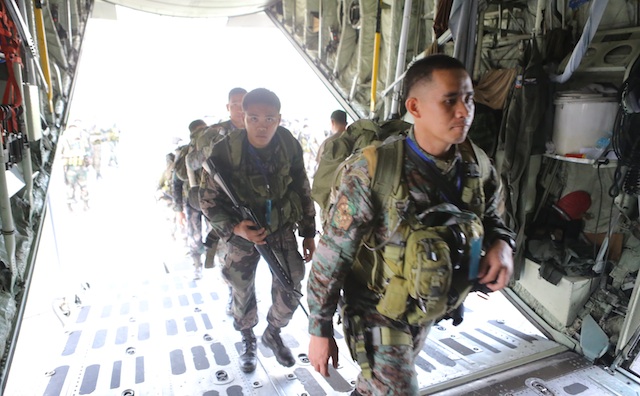
Situation:
Philippine National Police (PNP) personnel in affected areas were themselves typhoon victims, with many failing to report for work especially in Tacloban. Quoting the PNP, Aquino said after Haiyan, only “10% of [Tacloban City’s] established plantilla actually stuck to their posts.” Tacloban had a local police force of about 352 before Yolanda struck. The province of Leyte listed 1,151 and Southern Leyte, 495, in their provincial police offices.
PNP sources told Rappler that as of November 14, their initial list of missing police personnel in the calamity areas reached 983.
Just a day after the typhoon, widespread looting was reported in the city, which Aquino described to CNN “as very new to our experience.” Isolated shooting incidents fueled concerns of law and order breakdown, as little aid mounted survivors’ desperation. Reports from Tacloban painted a picture of anarchy and chaos. Without access to badly needed food and water, some survivors resorted to looting ATM machines and stores, following a complete shutdown of the city’s operations.
Response:
The national government deployed a total of 883 security personnel to Leyte, Samar, Cebu and Panay Islands – mostly Special Action Forces (SAF) from various provinces – including more than 400 to Tacloban City alone. By Monday, 3 days after the typhoon, Tacloban City implemented a dusk-to-dawn curfew.
But the deployment and curfew were initially not enough.
On Tuesday, 4 days since the typhoon, 8 people died in a stampede at one of the government’s rice warehouses in Tacloban. Police and military men were guarding the Alangalang town storage facility but were overpowered by the desperate crowd. Airport security also struggled to contain survivors who ran onto the tarmac and rushed towards landing planes, either for aid or in a bid to get on and escape Tacloban.
The military and PNP steadily increased its presence over the coming days, with the government sending almost 2,000 police, soldiers, and special forces to Leyte Island by Day 5. That day, gunshots forced the postponement of a mass burial in Tacloban.
By Day 7, police deployment reached 1,200 in Tacloban alone, including reinforcements from Manila. The military said 15,000 troops have been deployed to various affected areas. A semblance of law and order was observed a week since the storm. As aid trickled steadily and the exodus of victims became more organized, the focus of security personnel switched from crime prevention to relief effort support.
BODY RETRIEVAL AND HEALTH ISSUES

Situation:
In the aftermath of the storm, scores of dead bodies lined the streets of Tacloban City. More were trapped under the rubble. With no morgues to bring the bodies to, roads blocked, and survivors desperate for their basic needs, decaying corpses covered in cloth or mats remained on the streets even a week since Haiyan struck the city, leaving a powerful and unbearable stench of rotting flesh. Many bodies remain unidentified, as the number of dead and missing continue to rise and survivors begged the government to collect the dead.
Those who survived the storm also had their own problems. Those injured by the storm found themselves in a dire situation. Pharmacies were either swept away by storm surges or ransacked by looters, while many health staff were also unaccounted for. Just a day after the storm, hospitals faced medicine shortage and overcrowding. The World Health Organization (WHO) warned that those with significant injuries must be given immediate attention, especially those suffering with open wounds that risked getting infected. Diarrhea and wounds were the most reported condition, but mental health problems was also an immediate concern.
Response:
Two days after Haiyan, Aquino told reporters he tasked the AFP and DSWD to start retrieving bodies. Retrieval teams however, could not cope with the sheer amount of dead bodies.
It was only on Day 5 when clearing operations officially began, according to DOH Undersecretary Ted Herbosa. It was the same day when temporary burial sites were identified. On Day 6, Roxas told CNN he himself was helping with the collection of corpses. It was the same day the AFP deployed 3 trucks to Tacloban City to collect bodies.
Mass burials did not begin until that day. Tacloban City Mayor Alfred Romualdez said 110 corpses were buried by the Bureau of Fire Protection (BFP), before heavy digging machinery broke down. Romualdez estimated 2,000 corpses had been retrieved by local officials but said many more needed to be collected. A week since Haiyan, most bodies were put in cadaver bags, ready for mass burials. At least 392 bodies have so far been buried.
Injured survivors were being flown out of Tacloban City in the two days after Haiyan, with more serious cases flown to Cebu or East Avenue Medical Center in Quezon City. More sick and wounded had yet to be flown out on Wednesday, 5 days since the storm. As with food and water, the distribution of medicine continued to be a problem due to blocked roads.
Health assistance made progress on Tuesday, Day 4. That day, a 56-man team from the Department of Health (DOH) and a 31-man team from Albay took over Eastern Visayas Medical Center in Tacloban City which was the only functioning hospital by then. The DOH also sent a 55-member team of psychologists to Tacloban to assist dazed and traumatized survivors and at least 200 DOH personnel were also deployed to help the injured.
On the 5th day, Health Secretary Enrique Ona said in a statement that several cargoes of medicines, supplies, and equipment have already reached Tacloban via Cebu and Catbalogan, Samar. The DOH also had hospital tents set up in strategic areas.
POWER AND COMMUNICATIONS
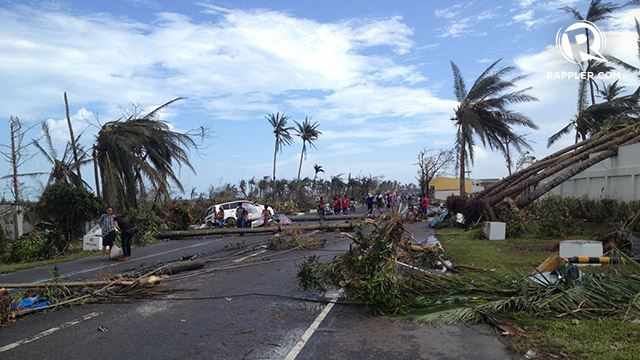
Situation:
Leyte and Eastern Samar were completely disconnected hours after Haiyan hit. All power and communication lines were down rendering the national government and outside provinces helpless and clueless about the situation there for the rest of the day.
Without basic communications service, coordination of support teams and assessment of damage were virtually nonexistent. Survivors were unable to call for help or inform families of their status and resorted to handwritten notes which they gave to members of the media in an attempt to let their loved ones outside of their provinces know of their condition.
Smart Communications said 15% of its cellular coverage in the regions affected by Haiyan were down, specifically Eastern Samar and Leyte. Globe Telecom said 53% of its network in the Visayas was adversely affected by the typhoon.
Electricity was also cut off. The day the typhoon hit, the National Grid Corporation of the Philippines (NGCP) said the entire Samar, Bohol, Cebu and Leyte provinces, along with Panay and Negros islands, were disconnected from the main power grid. The NGCP said 248 towers and 318 poles were damaged mostly in the Visayas including 7 substations, and described it as “by far the worst [damage] ever.”
Response:
Hours after the typhoon hit, the national government said restoration of power and connectivity was its priority. The next day, the United Nations and the Philippine government sent teams to Tacloban City to restore communication lines in the area and nearby provinces. The Philippine Army also set up an incident command post and radio contact center at the city police station, serving as the government’s contact to Leyte.
Major telecommunications companies Globe and Smart also worked closely with the government to help restore communication lines. By Monday, or Day 3, more areas in the Visayas had their services restored, including 70% of cellular services in Tacloban City, according to Almendras. This was not reflect on the ground, however. It remained difficult to make calls to to and from Tacloban City on Day 3.
Smart said 51% of Leyte and 14% of Eastern Samar was reactivated, while a total of 30 Globe cell sites were restored in Samar and Leyte. By Day 4, the AFP set up cell phone centers in Tacloban City to assist typhoon victims. Communication lines in Tacloban City began to normalize on Day 4.
The NGCP reported Sunday, or on Day 2, that power had been restored in some provinces in central Visayas affected by Yolanda but the hardest-hit areas were still in the dark, specifically Leyte and Samar.
On Day 4, the government said it was working with the Commission on Elections (Comelec) to dispatch generators to affected areas.
On Wednesday, or Day 5, the NGCP said it will take up to 6 weeks for them to completely restore power in Samar and Leyte. Meanwhile, power supply remains limited, so monitoring the power situation in the Visayas is also a priority for the NGCP. It said the supply-and-demand situation brought by limited power supply may curtail power in some areas in the region. A week since the typhoon, Biliran, Leyte, Southern Leyte, Northern Samar and Eastern Samar still had no power.
TRANSPORTATION
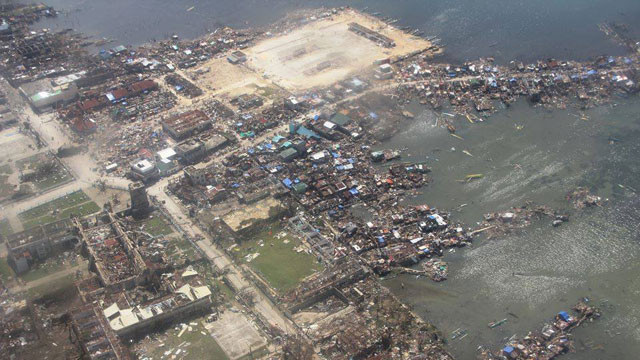
Situation:
After Haiyan, roads in badly-hit areas were blocked by debris and bodies, with some completely damaged by the winds and storm surge. Tacloban City airport was obliterated, leaving only the runway. Aerial photos of Eastern Samar and Leyte showed flattened homes and scattered debris, making any sort of transportation and relief distribution difficult.
On the day the typhoon hit, the Civil Aviation Authority of the Philippines (CAAP) suspended airport operations in Roxas, Caticlan, Legaspi, Iloilo, and Romblon until 6 pm Saturday, November 9.
Port operations, were also suspended as Yolanda brought giant waves that washed away homes in coastal areas. The Philippine Ports Authority said 16 ports were closed and vessels and fast craft were barred from sailing. Affected ports include Ormoc (Baseport), Baybay in Leyte, Palompon in Leyte, Naval in Biliran, Isabel in Leyte, Surigao, Lipata in Surigao, Batangas, Poctoy, Lucena, Tabaco, Masbate, Albay, Legazpi, Tagbilaran, and Dumaguete.
The port closures sealed the isolation of Eastern Samar and Leyte. This left only the damaged Tacloban City airport as the sole entry and exit point of relief goods and government personnel.
Response:
With a complete shutdown in transportation services and roads not passable in the hardest-hit areas, the national government knew the immediate need to clear roads to facilitate rescue and quick response operations was a priority. But Department of Public Works and Highways (DPWH) Secretary Rogelio Singson said DPWH’s personnel in Eastern Visayas were also victims of the devastation.
A day after the typhoon, Roxas said land routes from Metro Manila all the way to Tacloban were passable with the opening of the San Juanico bridge. By late afternoon, the national government was also able to clear the road to Tacloban airport.
On Day 3, Singson dispatched DPWH teams from other regions to help with clearing operations of Samar and Leyte’s national roads and bridges. While the Tacloban airport was also reopened with the help of soldiers assigned to man it, it was only used for daytime operations. This allowed C-130s in, and limited commercial flights mainly to Cebu. The C-130s allowed survivors to evacuate Tacloban. By the 4th day, national highways in affected areas were passable and able to provide mobility in key supply routes. The next day, transport operations resumed as highways and seaports opened, allowing victims to flee to other provinces.
But streets in cities, specifically Tacloban, were still not passable, making relief distribution difficult.
It was not until Day 6 that the government deployed 4 trucks for the AFP and DSWD to clear streets, along with 20 additional units of heavy equipment from the Metropolitan Manila Development Authority (MMDA), such as forklifts, dump trucks, pay loaders, and wing vans, among others, to help with clearing operations.
A week since the typhoon, operations in Tacloban remain limited, while all airports under CAAP are now operational. The AFP facilitated C130 flights to Manila from Ormoc, Guiuan, Tacloban and Cebu. DPWH said with national roads in Eastern Visayas finally open, it is now focused on clearing Tacloban City’s secondary and city roads.
National roads however still have limited lanes, with the DPWH estimating it will complete full right of way on its roads within 3-4 days.
Blaming national government
Over a week since the typhoon, even helpless local government officials couldn’t help but blame the national government.
Viscuso de Lira, mayor of Balangiga, one of the poorest towns in Eastern Samar, told Rappler on Saturday, November 16, that his town has been neglected, and last received aid on Tuesday, 4 days after the typhoon, but only for 560 families – not nearly enough for even a fifth of the 3,630 affected families.
“Masakit ‘yung loob ko eh. Kasi saan naman ako pupunta? Kailangan namin ng tulong. Napakahina. Ang bagal eh,” the mayor said. (It hurts me. Where will I go? We need help? It’s so incompetent. It’s so slow.)
Disaster management experts however are more understanding.
They concede that disasters of this scale will expectedly face delays in relief delivery because of the logistical challenges following such a devastating calamity – especially so when infrastructure and service lines break down. They say it is inevitable particularly when there are many competing priorities. (READ: Conversations with disaster experts)
But they also say these problems can be significantly decreased – with case studies to prove it. The burden, in the end, is on governments, which have the power and the means to lessen the impact of a calamity, even if it’s been caused by the world’s most powerful typhoon. – Rappler.com
Add a comment
How does this make you feel?
![[In This Economy] Is the Philippines quietly getting richer?](https://www.rappler.com/tachyon/2024/04/20240426-Philippines-quietly-getting-richer.jpg?resize=257%2C257&crop=194px%2C0px%2C720px%2C720px)
![[In This Economy] A counter-rejoinder in the economic charter change debate](https://www.rappler.com/tachyon/2024/04/TL-counter-rejoinder-apr-20-2024.jpg?resize=257%2C257&crop=267px%2C0px%2C720px%2C720px)
![[Vantage Point] Joey Salceda says 8% GDP growth attainable](https://www.rappler.com/tachyon/2024/04/tl-salceda-gdp-growth-04192024.jpg?resize=257%2C257&crop_strategy=attention)
![[ANALYSIS] A new advocacy in race to financial literacy](https://www.rappler.com/tachyon/2024/04/advocacy-race-financial-literacy-April-19-2024.jpg?resize=257%2C257&crop_strategy=attention)

There are no comments yet. Add your comment to start the conversation.